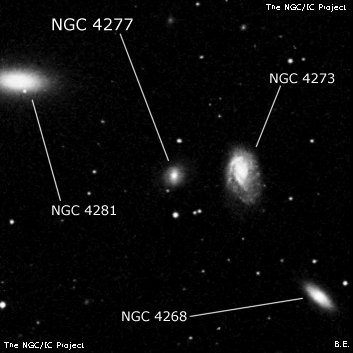
William Herschel discovered NGC 4277 = H II-570 = h1190 on 17 Apr 1786 (sweep 553) and recorded "Four [NGC 4270, 4273, 4277 and 4281], the time and number is that of the last [NGC 4281]. They are scattered about." There is nothing near his position, but exactly one degree south is[NGC 4281, the last of these four galaxies. Because of WH's error, John Herschel recorded h1190 (later NGC 4277) as a "nova" on 27 Dec 1827. But his RA was 47 seconds too large! In addition, his descriptions for h1189 and h1190 are reversed. Hermann Kobold measured an accurate micrometric position in 1893 (published in 1907) with the 18-inch refractor at Strasbourg.
400/500mm - 17.5" (3/28/87): faint, small, diffuse. A mag 14 star is 1.2' S of center. Located just 2.1' E of NGC 4273. Second faintest of 7 in the NGC 4273 group.
600/800mm - 24" (5/20/20): fairly faint, fairly small, elongated 4:3 ~NW-SE, 30"x24", very weak concentration. A mag 14 star is 1' S. Situated among several brighter Virgo cluster members and forms a close pair with NGC 4273 2' W.
SN 2020ftl, a Type Ia supernova in NGC 4277, was discovered on Apr 2nd. It reached nearly 14th magnitude but had faded to only mag 15.5 at the time of this observation. As the SN is located only 6" N of the nucleus, it was tough to pick out, but it was seen consistently as a faint stellar point.
24" (4/28/14): fairly faint to moderately bright, fairly small, round, 30" diameter, broad concentration. A mag 14-14.5 star lies 1.2' S of center. Forms a close pair with NGC 4273 2' W and nearly at the midpoint of NGC 4281 5' NE and NGC 4268 5' SW.
Notes by Steve Gottlieb